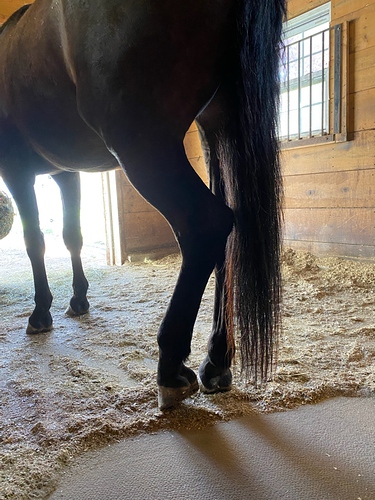Hi everyone,
*Picture of resting leg below.
I come again on behalf of my friend and her horse. Long story short (and I probably have a very incomplete version anyway) her horse started displaying some behavioral issues last fall, like bucking, spooking, and bolting in particular. Her horse also has a challenging personality (as in will challenge his rider) to start, but had never been unsafe until they point. Horse was scoped for ulcer and nothing was found. My friend sent her horse to a trainer over the summer, and the trainer expressed the horse also gave her a hard time, but she was able to cut the nonsense pretty early on, and then he did great. As far as physically, the only thing she noted was she felt his left stifle would get a little hitchy periodically, (so it was x-rayed with no findings, injected with estrogen or estradiol, I am not sure which) and that the farrier felt her needed shoes (which was what the other post was about.) He came home early fall, did fine for a while, and the bucking and bolting started again. Even before that started, she would mention regularly that he would stand funny on his left hind pretty constantly, and rarely rested the other leg. Sometimes it would out to the side or on the tip of his toe, and she was concerned about his stifles again.
Fast forward to winter when he hurt her pretty badly, and the vet same out again, after many correspondences about how he was standing oddly. The vet found the horse had some SI arthritis on the right side, which was discovered along with bilateral suspensory strains that were deemed extremely mild and more like just a little inflamed than a true strain. He also ultrasounded his stifles and found nothing. Her horse had his SI injected and shockwave was performed on his suspensories. After the first round of shockwave, the soft tissue had already returned to normal, tough the vet did finish out the series of 3 or 4. Throughout, he continued to stand funny. When it came time to start his rehab, he began acting out immediately, even with hand walking, which would be spooking and pulling away from her, which progressed to him bucking on the lunge, kicking out, and pulling free once again. He is much better with me, but he has even gotten me a couple of times. It seems like he starts getting very tight, tense, fussy, and then will explode. It can happen at any point- begining, middle, or end, or not at all. Ace does not seem to help except for making him more cranky since he needs to be pushed forward more, and still results in an explosion. He also counter bends when tracking right. Once trotting was introduced, we both noticed frequent stifle slips on downward transitions and when walking downhill and more on the leg he’s always resting. Around the same time, he started getting very grouchy about the saddle pads and saddle being placed on his back, but not when the girth was tightened. It seems to be associated only with his back, though I did mention ulcers. My friend wasn’t convinced, since this behavior was happening even when he scoped clean prior, though the back stuff is more new.
My friend was at the end of her rope because the vet keeps saying it’s fitness related, but she feels it’s pain, so she had him out again. He took x-rays of hocks and stifles which showed almost nothing except for maybe a tiny inflammation in the left stifle. He did find the horse was extremely reactive behind the wither, so they did full back rads, and found nothing. Saddle appears to fit fine and doesn’t make contact with the reactive area. Ultrasound shows the suspensories still looks great, as vet thought perhaps those were being aggregated with being reintroduced to work. He feels like the horse is still just unfit and that’s what is causing the stifle issues, but that doesn’t explain the poor behavior, grumpiness with saddle pads and saddle, or the resting of the hind leg, which really is pretty constant (and was happening even after coming home from the trainer when he was in peak fitness.) So, after all that, my poor friend was wondering if any of you have any insight into what could be going on, or where to look next. She’s put a lot into this guy, and is very frustrated at this point. I am sure I am missing a lot, but I might not be able to answer more questions but feel free to ask. Thank you all so very much. Picture of how he rests his leg is attached below.


